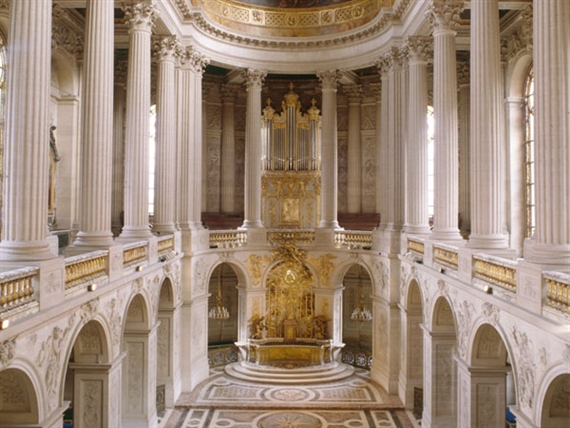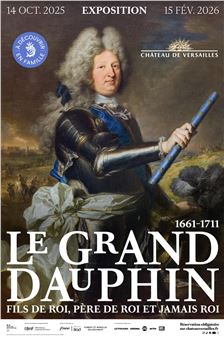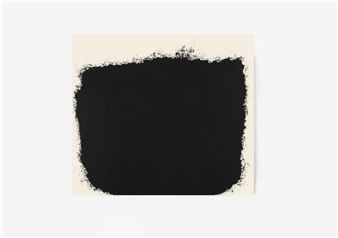A Chapel for the King
The work was undertaken by Jules Hardouin-Mansart in 1687 and completed in 1710 by Robert de Cotte, and the Royal Chapel of Versailles, a masterpiece of sacred art, became the theatre of the religious ceremonies of the Court. In accordance with the tradition of the Palatine Chapels, it has two levels. The principal gallery, above the entrance, was reserved for the royal family, while the side galleries were for the princes of royal blood and principal dignitaries of the Court; the other faithful were on the ground floor. The organ was placed in the loft over the high altar. Designed by Clicquot, its most famous organist was François Couperin.
The exhibition is divided into four sections:
- An evocation of the first Chapel (1672), a brilliant prefiguration of the definitive building.
- The Chapel of 1682, particularly well known from paintings and engravings because it was the religious building used for the longest time in the reign of Louis XIV. Located on the present site of the Salon d’Hercule, it was the scene of the Court’s religious life until 1710.
- The designing of the definitive Chapel, with drawings and engravings relating to the astonishing project for the dome in the centre of the north wing, up to the final magnificent drawings of the architectural office of Jules Hardouin-Mansart.
- The decor and the furniture of the Chapel when completed in 1710: sketches and preparatory paintings for the sumptuous compositions of La Fosse, Jouvenet and Coypel will be presented alongside drawings of the carved trophies on the ground floor and documents enabling visitors to get a clearer idea of the furniture that has not survived.
Around the exhibition
To accompany the celebration of this tercentenary, the annexes of the Chapel will be opened for guided visits (in French): the sacristies, the oratory of Madame de Pompadour, as well as the rooms used by the choristers and the members of the King’s orchestra. These preserved annexes will enable visitors to get a glimpse of the conditions of the daily life of the various incumbents of the Royal Chapel during the Ancien Régime.

The work was undertaken by Jules Hardouin-Mansart in 1687 and completed in 1710 by Robert de Cotte, and the Royal Chapel of Versailles, a masterpiece of sacred art, became the theatre of the religious ceremonies of the Court. In accordance with the tradition of the Palatine Chapels, it has two levels. The principal gallery, above the entrance, was reserved for the royal family, while the side galleries were for the princes of royal blood and principal dignitaries of the Court; the other faithful were on the ground floor. The organ was placed in the loft over the high altar. Designed by Clicquot, its most famous organist was François Couperin.
The exhibition is divided into four sections:
- An evocation of the first Chapel (1672), a brilliant prefiguration of the definitive building.
- The Chapel of 1682, particularly well known from paintings and engravings because it was the religious building used for the longest time in the reign of Louis XIV. Located on the present site of the Salon d’Hercule, it was the scene of the Court’s religious life until 1710.
- The designing of the definitive Chapel, with drawings and engravings relating to the astonishing project for the dome in the centre of the north wing, up to the final magnificent drawings of the architectural office of Jules Hardouin-Mansart.
- The decor and the furniture of the Chapel when completed in 1710: sketches and preparatory paintings for the sumptuous compositions of La Fosse, Jouvenet and Coypel will be presented alongside drawings of the carved trophies on the ground floor and documents enabling visitors to get a clearer idea of the furniture that has not survived.
Around the exhibition
To accompany the celebration of this tercentenary, the annexes of the Chapel will be opened for guided visits (in French): the sacristies, the oratory of Madame de Pompadour, as well as the rooms used by the choristers and the members of the King’s orchestra. These preserved annexes will enable visitors to get a glimpse of the conditions of the daily life of the various incumbents of the Royal Chapel during the Ancien Régime.

 ARTISTS
ARTISTS











